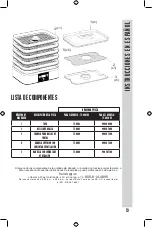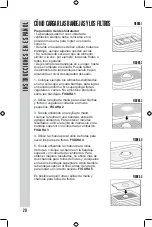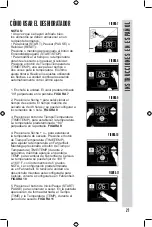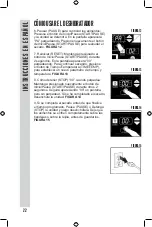
ENGLISH INSTRUCTIONS
8
• For food safety, to help ensure any bacteria present are destroyed, choose
pretreatment or post treatment from below:
• Pretreatment of Meat Prior to Dehydrating – Heat oven to 350°F (177°C).
Drain and discard marinade from meat. Pat dry with paper towels and place
meat in a single layer, leaving a space around each piece on baking sheet.
Bake 5 to 10 minutes or until internal temperature reaches 160°F (72°C).
Poultry must reach 165°F (74°C). NOTE: This method may reduce drying time
and may result in a drier texture.
• Post Treatment of Meat After Dehydrating – Heat oven to 275°F (135°C).
Line a large baking sheet with foil. Place jerky in a single layer, leaving a small
space around each piece. Bake for 10 to 12 minutes. Cool completely on a
wire rack. Pat jerky dry with paper towels to remove any surface fats before
storing.
• Marinating meats helps with the flavor and texture of jerky. Do not marinate
meat longer than recipe or package directions call for.
TIP: Post treatment of meat after dehydrating may result in a more desirable
jerky texture. Try each treatment to determine which jerky you like best.
• Visit www.usda.gov for any questions on meat and food safety.
• Never dehydrate meats with fruits and vegetables, due to cross-
contamination of foods. Meats dry at a different temperature from fruits or
vegetables.
• All dehydrated foods must be cooled completely before storing.
• For food safety, complete the food drying process. Do not start and stop the
process for longer than 5 minutes. You may pause the process to check on
the food’s dryness or to remove dehydrated pieces.
• Label and date all containers of dried foods.
FOOD SAFETY TIPS
A. Food Preparation
• Always wash hands before starting food preparation.
• Wash all fruits and vegetables before preparation.
• Choose fruits and vegetables that are in season for the best flavor.
• Discard any fruits and vegetables that have bruises or mold.
• Cut foods the same thickness, size, or shape before drying to ensure even
drying.
• Some foods, like garlic, onions, cauliflower, and broccoli, have a strong smell
when drying.
B. Pre-treatment
• Some fruits and vegetables require pretreatment before drying. Blanch or
add color protectors to preserve natural color.
How to Blanch
Blanching is recommended for some vegetables to help prevent color and
flavor loss during drying and storage. Blanching is used to break the skins on
some fruits to help shorten the drying process.
• Bring a large stockpot filled with cold water to a rolling boil.
• Place cleaned fruits or vegetables in a strainer with a handle.
• Dip strainer into the boiling water for the recommended time.
• Make sure that all the fruits or vegetables are covered with water for even
blanching.
DEHYDRATING FRUITS AND VEGETABLES









































